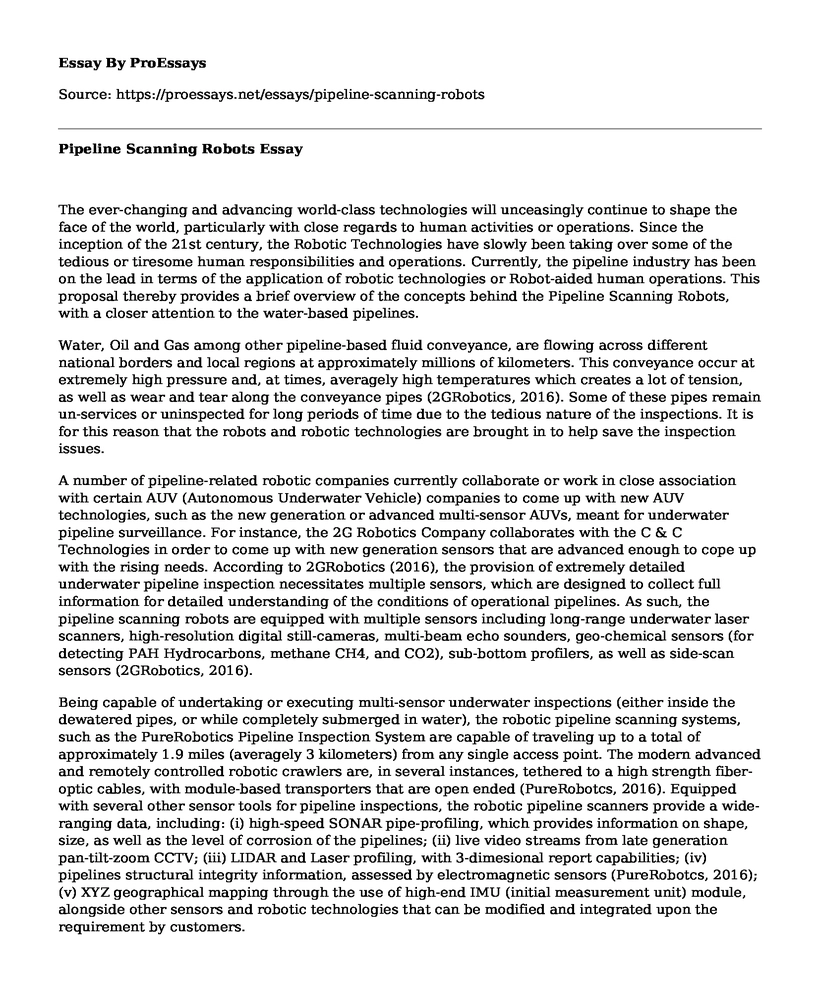The ever-changing and advancing world-class technologies will unceasingly continue to shape the face of the world, particularly with close regards to human activities or operations. Since the inception of the 21st century, the Robotic Technologies have slowly been taking over some of the tedious or tiresome human responsibilities and operations. Currently, the pipeline industry has been on the lead in terms of the application of robotic technologies or Robot-aided human operations. This proposal thereby provides a brief overview of the concepts behind the Pipeline Scanning Robots, with a closer attention to the water-based pipelines.
Water, Oil and Gas among other pipeline-based fluid conveyance, are flowing across different national borders and local regions at approximately millions of kilometers. This conveyance occur at extremely high pressure and, at times, averagely high temperatures which creates a lot of tension, as well as wear and tear along the conveyance pipes (2GRobotics, 2016). Some of these pipes remain un-services or uninspected for long periods of time due to the tedious nature of the inspections. It is for this reason that the robots and robotic technologies are brought in to help save the inspection issues.
A number of pipeline-related robotic companies currently collaborate or work in close association with certain AUV (Autonomous Underwater Vehicle) companies to come up with new AUV technologies, such as the new generation or advanced multi-sensor AUVs, meant for underwater pipeline surveillance. For instance, the 2G Robotics Company collaborates with the C & C Technologies in order to come up with new generation sensors that are advanced enough to cope up with the rising needs. According to 2GRobotics (2016), the provision of extremely detailed underwater pipeline inspection necessitates multiple sensors, which are designed to collect full information for detailed understanding of the conditions of operational pipelines. As such, the pipeline scanning robots are equipped with multiple sensors including long-range underwater laser scanners, high-resolution digital still-cameras, multi-beam echo sounders, geo-chemical sensors (for detecting PAH Hydrocarbons, methane CH4, and CO2), sub-bottom profilers, as well as side-scan sensors (2GRobotics, 2016).
Being capable of undertaking or executing multi-sensor underwater inspections (either inside the dewatered pipes, or while completely submerged in water), the robotic pipeline scanning systems, such as the PureRobotics Pipeline Inspection System are capable of traveling up to a total of approximately 1.9 miles (averagely 3 kilometers) from any single access point. The modern advanced and remotely controlled robotic crawlers are, in several instances, tethered to a high strength fiber-optic cables, with module-based transporters that are open ended (PureRobotcs, 2016). Equipped with several other sensor tools for pipeline inspections, the robotic pipeline scanners provide a wide-ranging data, including: (i) high-speed SONAR pipe-profiling, which provides information on shape, size, as well as the level of corrosion of the pipelines; (ii) live video streams from late generation pan-tilt-zoom CCTV; (iii) LIDAR and Laser profiling, with 3-dimesional report capabilities; (iv) pipelines structural integrity information, assessed by electromagnetic sensors (PureRobotcs, 2016); (v) XYZ geographical mapping through the use of high-end IMU (initial measurement unit) module, alongside other sensors and robotic technologies that can be modified and integrated upon the requirement by customers.
In conclusion, the robotic pipeline scanning technologies have generally rescued humans from the tiresome undertakings that were initially performed manually by men. The technology has eliminated the manned entries into the pipes and the need for dewatering during the pipeline inspections. The technology employs scanners, sensors, cameras and other detection tools for pipeline inspections. Their demand and domination of the modern pipeline industry thereby explains the technologys effectiveness and efficiency.
References
2GRobotics (2016). Underwater Laser Scanning for Subsea Pipelines. Retrieved on 30th September, 2016, from http://www.2grobotics.com/underwater-laser-scanning-for-subsea-pipelines-as-featured-in-the-april-edition-of-marine-technologies-reporter/
PureRobotcs (2016). Pure Technologies: Robotic Pipeline Inspections. Retrieved on 30th September, 2016, from https://www.puretechltd.com/technologies-brands/pure-robotics.
Cite this page
Pipeline Scanning Robots. (2021, Mar 23). Retrieved from https://proessays.net/essays/pipeline-scanning-robots
If you are the original author of this essay and no longer wish to have it published on the ProEssays website, please click below to request its removal:
- History on Wells Fargo and how it pertains to California's State History
- Assignment Example on Chemical Formulations
- Time Period Impact to Forest Groundwater Levels Saltwater Intrusion Farming Industrial Development Population
- Hair Strength and pH Level of Shampoo Essay
- Geology of Abu Dhabi: 150m High Dune Ridges & Evaporitic Flats - Essay Sample
- Essay Example on the Potential of Blockchain AI and Alexa: Disrupting the Future
- Essay Example on Marco Polo: A Brief History of the Explorer







